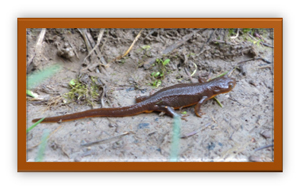Snake vs Newt: A Toxic Tango
By Paul Snoey
The Rough-skinned newt is very common in Ridgefield. Although they are at home in the water, they make forays away from the water, especially during the wet months of the year. They make no attempt to hide, seemingly indifferent to the dangers of being exposed. This is unlike most other salamanders that live life hidden away. Slow and lumbering, they could be easy prey for many predators. Perhaps they are oblivious because they carry a deadly weapon. They are extremely poisonous. They carry a poison called tetrodotoxin, called TTX for short. This is the same toxin found in a species of pufferfish popular with Japanese gourmands where it has killed as many as fifty people a year. Improperly prepared fish can cause the poisoning. Poisoning with the newt is rare. People simply don’t eat this animal and it has no fangs to inject poison. There was a case in Oregon where a young man in a tavern swallowed one on a dare. He died even with life support.
 Why so toxic? Well, they do have a predator, the common garter snake. Garter snakes have developed a tolerance to TTX and will readily eat most newts. They can sense if the newt may be too toxic for their system and will leave those alone. Researchers at Oregon State have measured the toxins in newts and the resistance in garter snakes from British Columbia to California. Newts in BC are almost toxin free and newts in southern Oregon can be loaded with TTX. Common garter snakes in BC have almost no resistance to the toxin and garter snakes in southern Oregon are highly resistant. Since there seems to be a north south gradient we could guess that our newts are moderately toxic and our snakes have moderate resistance. Nick Crockford of Ridgefield Public Works once found a newt in a sewer pump station and threw it out on the parking pad. He observed that a moment later, a garter snake rushed out, grabbed it, and then swallowed it. In the area of the salmon incubator this year, there has been an abundance of newts. They may readily take a salmon egg or developing fry if they could catch it. That concern led to do some reading for this article. For those interested, please find below a short video from National Geographic showing just how toxic a newt can be and why.
Why so toxic? Well, they do have a predator, the common garter snake. Garter snakes have developed a tolerance to TTX and will readily eat most newts. They can sense if the newt may be too toxic for their system and will leave those alone. Researchers at Oregon State have measured the toxins in newts and the resistance in garter snakes from British Columbia to California. Newts in BC are almost toxin free and newts in southern Oregon can be loaded with TTX. Common garter snakes in BC have almost no resistance to the toxin and garter snakes in southern Oregon are highly resistant. Since there seems to be a north south gradient we could guess that our newts are moderately toxic and our snakes have moderate resistance. Nick Crockford of Ridgefield Public Works once found a newt in a sewer pump station and threw it out on the parking pad. He observed that a moment later, a garter snake rushed out, grabbed it, and then swallowed it. In the area of the salmon incubator this year, there has been an abundance of newts. They may readily take a salmon egg or developing fry if they could catch it. That concern led to do some reading for this article. For those interested, please find below a short video from National Geographic showing just how toxic a newt can be and why.
http://video.nationalgeographic.com/video/weirdest-newt
